
With a population of about 129 million in 2022, Mexico is the 10th most populated country in the world. It is the largest Spanish-speaking country in the world and the third-most populous country in the Americas after the United States and Brazil, the most populous city in the country is the capital, Mexico City, with a population of 9.2 million and its metropolitan area is also the most populated with 21.8 million as of 2020. Approximately 53% of the population lives in one of the 48 large metropolitan areas in the country. In total, about 76% of the population of the country lives in urban areas and 23% lives in rural ones.
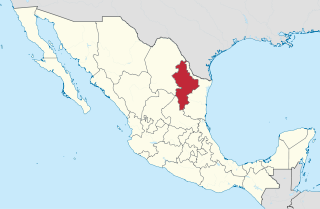
Nuevo León, officially the Free and Sovereign State of Nuevo León, is a state in northeastern Mexico. The state borders the Mexican states of Tamaulipas, Coahuila, Zacatecas, and San Luis Potosi, and has an extremely narrow international border with the U.S. state of Texas. Covering 64,156 square kilometers and with a population of 5.78 million people, Nuevo León is the thirteenth-largest federal entity by area and the seventh-most populous as of 2020.

The Nahuas are a Uto-Nahuan ethnicity and one of the indigenous people of Mexico, with Nahua minorities also in El Salvador, Guatemala, Honduras, Nicaragua, and Costa Rica. They comprise the largest indigenous group in Mexico, as well as the largest population out of any North American Indigenous people group who are native speakers of their respective indigenous language. Amongst the Nahua, this is Nahuatl. When ranked amongst all Indigenous languages across the Americas, Nahuas list third after speakers of Guaraní and Quechua.

The region known as Hispanic America and historically as Spanish America or Castilian America is all the Spanish-speaking countries of the American continent. In all of these countries, Spanish is the main language - sometimes sharing official status with one or more indigenous languages or English, and Latin Catholicism is the predominant religion.

Mexicans are the citizens and nationals of the United Mexican States. The Mexican people have varied origins with the most spoken language being Spanish, but many also speak languages from 68 different Indigenous linguistic groups and other languages brought to Mexico by expatriates or recent immigration. In 2020, 19.4% of Mexico's population identified as Indigenous. There are currently about 12 million Mexican nationals residing outside Mexico, with about 11.7 million living in the United States. The larger Mexican diaspora can also include individuals that trace ancestry to Mexico and self-identify as Mexican but are not necessarily Mexican by citizenship. The United States has the largest Mexican population in the world after Mexico at 37,186,361 in 2019.

Latin Americans are the citizens of Latin American countries.

The Huasteclanguage, now commonly known by the endonym Téenek, of Mexico is spoken by the Téenek people living in rural areas of San Luis Potosí and northern Veracruz. Though relatively isolated from them, it is related to the Mayan languages spoken further south and east in Mexico and Central America. According to the 2005 population census, there are about 200,000 speakers of Huasteco in Mexico. The language and its speakers are also called Teenek, and this name has gained currency in Mexican national and international usage in recent years.
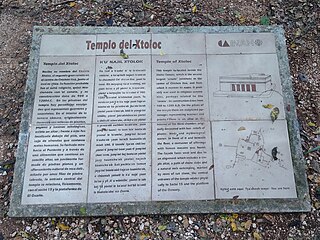
The Constitution of Mexico does not declare an official language; however, Spanish is the de facto national language spoken by over 99% of the population making it the largest Spanish speaking country in the world. Due to the cultural influence of the United States, American English is widely understood, especially in border states and tourist regions, with a hybridization of Spanglish spoken. The government also recognizes 63 indigenous languages spoken in their communities out of respect, including Nahuatl, Mayan, Mixtec, etc.

Indigenous peoples of Mexico, Native Mexicans or Mexican Native Americans, are those who are part of communities that trace their roots back to populations and communities that existed in what is now Mexico before the arrival of Europeans.

Arandas is a municipality of the Altos Sur region of the state of Jalisco in Mexico. Arandas is also the name of the municipality's main township and the center of the municipal government. The city centre is located approximately 86 miles (138 km) east of Guadalajara, the state capital. Arandas is accessible to residents of Guadalajara by the Mexican Federal Highway 80D and Jalisco State Highway 314.
Acayucan is a municipality in the Mexican state of Veracruz. It is located in the state's southeast, in the Olmeca region. The municipal seat is the city of Acayucan, Veracruz. It covers a total of 724.65 km2.
The languages of North America reflect not only that continent's indigenous peoples, but the European colonization as well. The most widely spoken languages in North America are English, Spanish, and to a lesser extent French, and especially in the Caribbean, creole languages lexified by them.

The official language of Nicaragua is Spanish; however, Nicaraguans on the Caribbean coast speak indigenous languages and also English. The communities located on the Caribbean coast also have access to education in their native languages. Additionally, Nicaragua has four extinct indigenous languages.
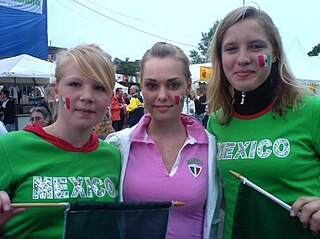
White Mexicans are individuals in Mexico who identify as white, often due to their physical appearance or their recognition of European or West Asian ancestry. The Mexican government conducts ethnic censuses that allow individuals to identify as "White," but the specific results of these censuses are not made public. Instead, the government releases data on the percentage of "light-skinned Mexicans" in the country, with nationwide surveys conducted by the Mexico's National Institute of Statistics, the National Council to Prevent Discrimination and contemporary sources such as Encyclopædia Britannica reporting results that average 32%. The term "Light-skinned Mexican" is preferred by both the government and media to describe individuals in Mexico who possess European physical traits when discussing ethno-racial dynamics. However, "White Mexican" is still used at times.
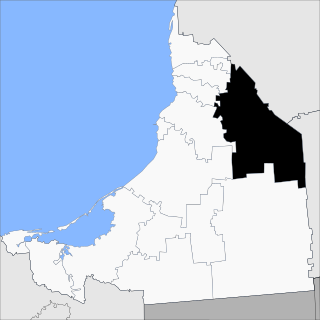
Hopelchén is one of the 13 municipalities in the Mexican state of Campeche. It is situated inland in the north of the state. The municipal seat, and largest settlement, is the city of Hopelchén.
The Censo de Población y Vivienda is the main national population census for Mexico. It is compiled by the National Institute of Statistics and Geography (INEGI), a decentralized agency of the Mexican Federal government, with the purpose of collating and reporting detailed demographic, socioeconomic and geographical data from across the nation, and is conducted every ten years.

Zacatecas, officially the Free and Sovereign State of Zacatecas, is one of the 31 states of Mexico. It is divided into 58 municipalities and its capital city is Zacatecas.
Atenango del Río is a city in the southern Mexican state of Guerrero. It serves as the seat of the surrounding municipality of Atenango del Río.
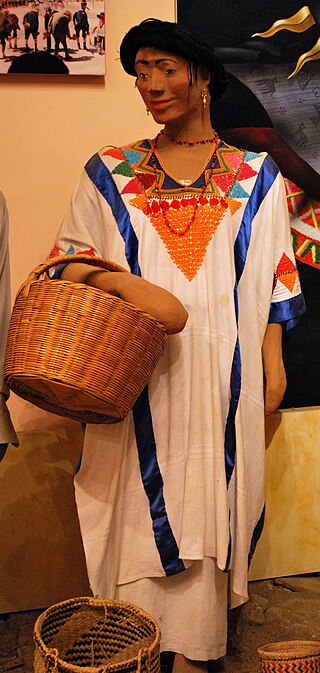
The state of Oaxaca, Mexico has a total population of about 3.5 million, with women outnumbering men by 150,000 and about 60% of the population under the age of 30. It is ranked tenth in population in the country. Fifty three percent of the population lives in rural areas. Most of the state’s population growth took place between 1980 and 1990. Life expectancy is 71.7 for men and 77.4 for women, just under the national average. Births far outpace deaths. In 2007, there were 122,579 births and 19,439 deaths. Approximately 85% profess the Catholic faith.
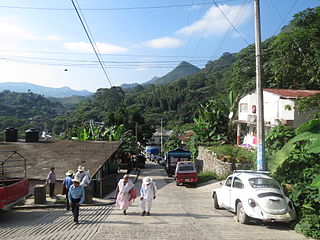
Huehuetla is a rural municipality in Puebla, Mexico.


















